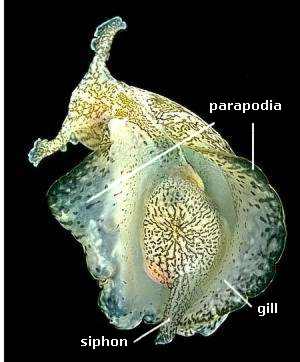Behavioral Neuroscience, lecture on Aplysia and its behavior
Defensive Behaviors - Siphon Withdrawal
I. Aplysia
A. Sea Hares
1. Aplysia californica, A. brasiliana, A. dactylomela, A. depilans
A. extraordinaria, A. fasciata, A. punctata, A. oculifera,
B. Global Marine invertebrate - mullusca - subclass opisthobranch - order Aplysiacea
1. Low rocky intertidal habitat
a. Herbiverous - feeds on larger algae
2. Large size (> 5 inches), reduced shell (buried in mantle)
a. mantle cavity with gill and siphon
b. purple ink - defensive response
3. Cephalic tentacles - 2 pairs
4. Hermaphroditic
a. both male and female roles in copulation
i. up to 500 million eggs laid at a time
C. Nervous system contains ~20,000 neurons
1. cell bodies mostly in paired bilateral ganglia
a. rostral to caudal: buccal, cerebral,
pleural - dorsal / pedal - ventral,
fused abdominal (left)/fused viseral (right)
II. Behavior - Siphon withdrawal reflexes
A. Gill and Siphon reside in Mantle cavity
1. gills absorb O2 from sea H2O
a. also excrete CO2 and ammonia products (NH3)
2. siphon draws oxygenated H2O across gill
a. pumps wastes away from gill
B. Gill and Siphon may be muscularly withdrawn into the mantle to protect them
1. Withdrawal reflex elicited by tactile sensory input
a. electrical stimulation also causes withdrawal
C. Reflex
1. Simplest behavioral response - requires only 3 neurons
a. sensory input
i. often specialized sensory organ
(1) input signal may be graded
ii. afferent (toward central nervous system)
b. interneuron(s)
i. gating
ii. this site is the only possibility for modifying the behavior
iii. enhancing, limiting, delaying,
repeating, priming, learning
(1) may require additional circuits
(2) may require hormonal or
neuropeptide modulation
c. motor output = efferent (away from CNS)
i. always cholinergic (ACh) in vertebrates
D. Tail - Siphon withdrawal reflex
1. defensive response
2. also stimulated by tactile or electrical sensory stimulation
